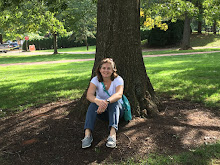I wrote last week about International Dot Day celebrated September 15 this year.
What I forgot to add is that the real date is September 15th-ish.
The beauty of
this is that Dot Day celebrations can continue throughout the fall. For more about
Ishful thinking, see Peter Reynolds book, Ish.
Reading The Dot by Peter Reynolds for Dot Day this year I noticed a few new themes
in the story.
For those of you not familiar with the story, I offer a quick summary to help my
reflections make sense. I highly recommend you check out the book for yourself
to experience the full story as it is told through pictures and words.
The Dot begins with a child frustrated in art class. She sits staring at a blank
piece of paper at the end of class. The teacher suggests she just make a mark
so the child jabs her marker on the page, making a dot. The teacher tells her to
sign it and the child does so, leaving the paper behind as class ends. She returns
the following week to find her signed dot hung in a gilded frame.
The child is
surprised to see her work honored and displayed in this way. She soon decides she
can do better and she sets out on an artistic journey creating more dots, exploring
size, color, and design variations as she creates an entire collection of dot art.
The book ends when the child has her dots featured in the school art show. She
is approached by a boy who makes that classic complaint of many intimidated by
art, "I can't draw a straight line with a ruler." The girl suggests he show her
and then tells him to sign his mark, leaving the reader to imagine what might come
next for this boy as he begins an artistic journey with his squiggle.
The challenge for Dot Day is "Make your mark and see where it takes you!" This
is a great starting point and a fun one to explore with kids, especially as we begin
a new school year. Reading The Dot this year, I notice new themes and would add
to that challenge, "Make your mark and own it. See where it takes you and share
your journey."
"Make your mark and own it..." The request to sign a first mark is powerful at
both the beginning and the end of this story. Signing a work is a mark of authorship.
It seems that taking ownership of these first marks leads to a feeling of inner
authority. The teacher's role in framing the work, allows the student to reflect
on her first mark and to challenge herself to further exploration.
"...See where it takes you and share your journey." It is in the sharing of her
creations that the main character meets another child who also longs to be an artist.
I recently read Show Your Work by Austin Kleon, a book that offers a guide for
creative people wanting to gain a broader audience. As the title suggests, the
book offers ideas and examples of ways artists can show their work during the creative
process rather than waiting to have it all figured out with a finished project at
the end. Kleon even suggests that viewers prefer this, people like to hear the
story behind works of art and feel like they are part of the unfolding by getting
to see the steps and hear about discoveries along the way.
In our work at Art at the Center, we try to build this sharing into aspects of making
across age levels. For our toddler artists, simply pinning their art to the board
and encouraging them to look at the colorful wall before leaving class invites a
reflection on these wonderful first marks. For our preschool artists, signatures
on work denote authorship and also become part of the artists' overall sense of
design in wonderful ways. Artists at this age begin to tell elaborate stories about
the settings and characters in their creations. We write these stories to display
with the work, allowing a glimpse into the creative thinking behind the work. For
our grade school artists, sketchbooks and portfolios allow artists to collect work
over time and see themes emerge. Our weekly sharing time and end of session display
for parents further allow children to share both finished products and unique steps
in the process such as mixing a unique color or sketching out a plan for a sculpture.
This fall for our evening studio, Jenna has added time for creating a digital portfolio
and reflecting on work over the course of the session allowing middle school and
teen artists the ability to use technology to share their work and process with
a wider audience.
Subscribe to:
Post Comments (Atom)

No comments:
Post a Comment